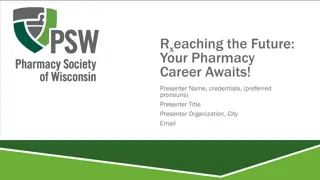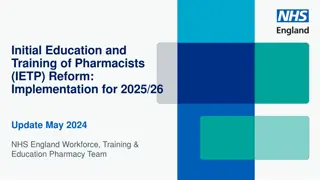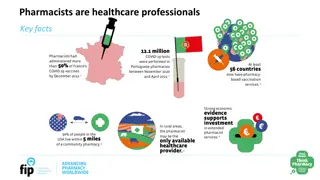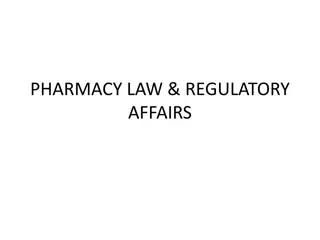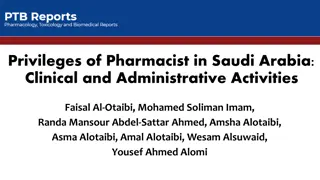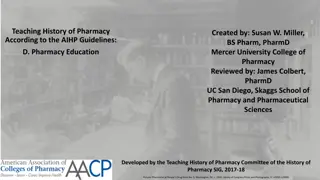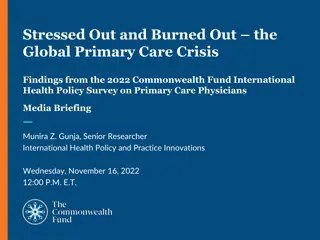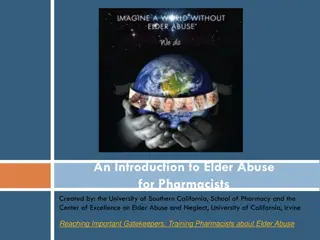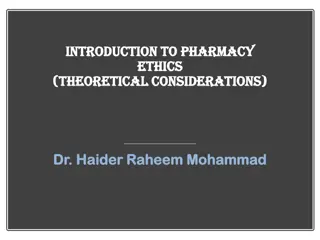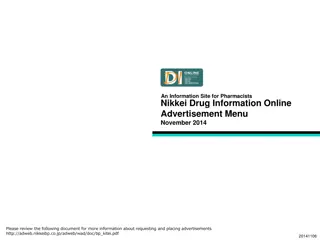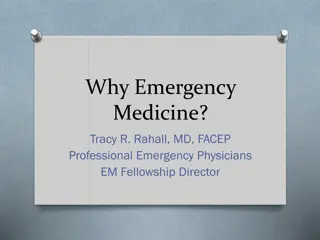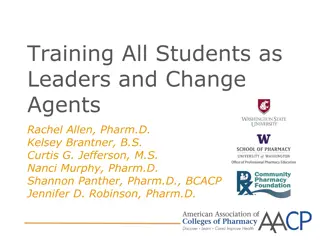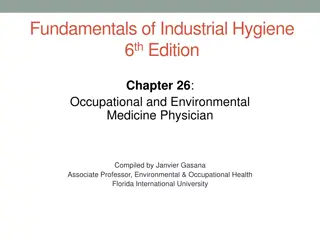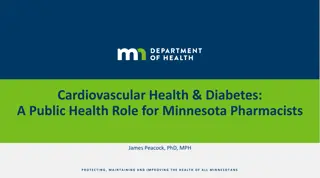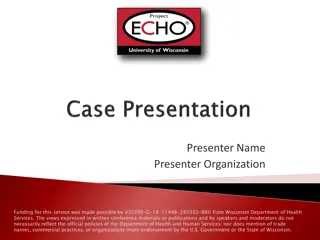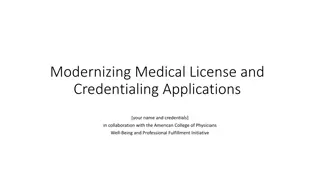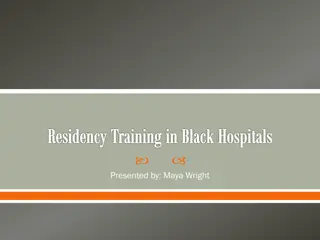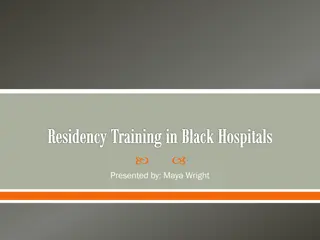Exploring Potential Collaboration Between Physicians and Pharmacists
The study focused on assessing the potential for inter-professional collaboration between physicians and pharmacists in patient medication management. Parallel surveys were conducted among members of the WREN and PEARL Rx research networks, revealing insights on perceptions, frequency of interaction, communication preferences, interest in joint projects, and medication list updates after patient transitions. Response summaries and geographic dispersion by county were provided, highlighting the engagement and perspectives of clinicians in Wisconsin.
Download Presentation

Please find below an Image/Link to download the presentation.
The content on the website is provided AS IS for your information and personal use only. It may not be sold, licensed, or shared on other websites without obtaining consent from the author. Download presentation by click this link. If you encounter any issues during the download, it is possible that the publisher has removed the file from their server.
E N D
Presentation Transcript
PEARL Rx and WREN Partnership: Parallel Surveys To Explore Potential Inter-Professional Collaboration Betty A. Chewning, PhD., FAPhA David H. Kreling, RPh, PhD David Hahn, MD, MS 2013 Wisconsin Health Improvement and Research Partnerships Forum 12 September 2013 Union South, University of Wisconsin - Madison
The current environment for outpatient care includes: focus on quality of care and outcomes increasing time pressures on clinicians increased complexity and medications in a central role increased emphasis on inter-professional collaboration Consequently, physicians and pharmacists are likely partners for increasingly working together, especially around patient medication management.
Objective: To survey members of the Wisconsin Research Education Network (WREN) and the Pharmacy Practice Enhancement Action Research Link RX (PEARL Rx) to assess possibilities for inter-professional collaboration around patient medication management. This survey is a product of the collaboration between the WREN team and the PEARL team and respondents. Acknowledgements Lois Sater (PEARL RX) Erin Leege (WREN) Roberta Carrier, RPh
Methods: Design: Parallel surveys for physicians and pharmacists Samples: WREN and PEARL RX research network members Administration: Email contacts; Qualtrics online survey platform Survey: 1. Perceptions about a set of patient-care pharmacist activities MDs: already have RPhs do, would like RPh to do, not interested RPhs: already provide, would like to provide, not interested 2. Frequency of direct interaction about patient care MD RPh and RPh MD 3. Preferred method of communicating MD most preferred method RPh what method works best 4. Interest in working on a joint project 5. Percent of patients for whom they get up-to-date medication lists after transition home from hospitalization or NH care
Response Summary PEARL RX (RPhs): A total of 41 usable responses from 59 contacted (69.5%) WREN (MDs): 83 MDs (out of ~300 contacted) accessed the survey; Usable data for 63 respondents (21%); Clinician Type: MD: 54, DO: 2, PA: 3, NP: 3, not stated:1 WREN Survey member: 43 yes (68%), 3 no (5%), 16 not sure (27%)
Response Summary Geographic Dispersion (by County) WREN - MD PEARL RX - RPh Dane Milwaukee Monroe Juneau Outgamie (2) Barron, Dodge, Fond du Lac, Rock, Sheboygan, Waukesha, Wood (1) Chippewa, Dunn, Eau Claire, Grant, Kenosha, Marinette Richland, Sauk, Trempeleau Winnebago 12 10 5 5 3 Dane La Crosse Manitowoc Milwaukee (1) Brown, Dodge, Dunn, Grant, Green, Jackson, Rock, Shawano, Walworth Washington, Waupaca Winnebago 12 9 3 3
WREN (MDs) 90% Perceptions about Pharmacist Services 80% 70% 60% 50% 40% 30% 20% 10% 0% Med Reconcil Device Ed Monitor Pt Status Med Afford Assist DailyDose Orchestr Optimiz Tx Decns Pt Med Chk- Up Yes Would Like Not Interested 90% PEARL RX (RPhs) 80% 70% 60% 50% 40% 30% 20% 10% 0% Med Reconcil Device Ed Monitor Pt Status Med Afford Assist DailyDose Orchestr Optimiz Tx Decns Pt Med Chk- Up Yes Would Like Not Interested
40% Pharmacist Contact Physician 35% 30% 25% 20% 15% 10% 5% 0% MD RPh Daily Weekly Monthly Annually Never WREN (MD): how often contact you about patient care issues beyond RX order information? PEARL RX (RPh): not including to obtain RX orders, how often interact about care for their patients?
Physician Contact Pharmacist 50% 45% 40% 35% 30% 25% 20% 15% 10% 5% 0% MD RPh Daily Weekly Monthly Annually Never WREN (MD): how often interact for input and experience relevant to patients you care for? PEARL RX (RPh): other than to provide RX info, how often contact you about their patients?
Preferred Method for Communicating 80% 70% 60% 50% 40% 30% 20% 10% 0% FAX Phone Email Shared Elec Face/In person MD RPh WREN (MD): most preferred method for communicating with pharmacists PEARL RX (RPh): What methods work best for you to communicate (check all)
Interest in a Joint Project? 80% 70% 60% 50% 40% 30% 20% 10% 0% Yes No Possibly MD RPh Would you be interested at some point in working with physicians/pharmacists in your region on a joint project?
Up-to-date Medication Lists after Transition Home from Hospital or NH Care 40% 35% 30% 25% 20% 15% 10% 5% 0% 0% <= 20% 21 - 40% 41 - 60% 61 - 80% 81 - 99% 100% MD RPh For about what percent of your patients do you get up-to-date medication lists following a transition home from hospitalization or nursing home care?
Conclusions Considerable interest was present from both groups for many of the pharmacist services. Pharmacists more often reported daily or weekly interactions about patient care issues around half for both directions of contact. Traditional means of communicating (phone and FAX) remain common; shared electronic records also used by ~25+% of both groups. A high proportion of both groups expressed interest in potentially working on a joint project.
Implications Moving Forward Interest in the services and in potentially working on a joint project suggests doors may be open for enhanced collaboration. However, for some, the extent of interaction was low - an area for development and growth. Next steps? Begin exploring mutual studies. Key in on RFA opportunities, identify prospect(s) for project idea or interventions involving both groups (keying in on enhancing patient care, quality, and outcomes). Explore geographic overlap for possible projects Devise means for growing network memberships in areas for critical masses, perhaps via collaborative recruiting (WREN clinics approach the pharmacists they work with to join Pearl-Rx and vice versa) Others???


